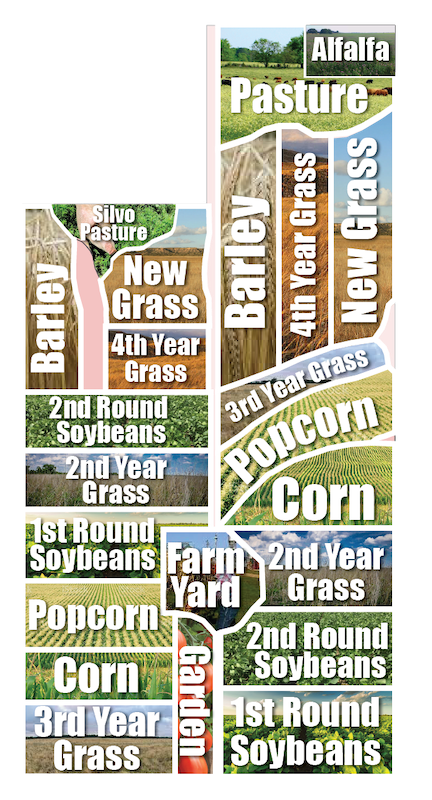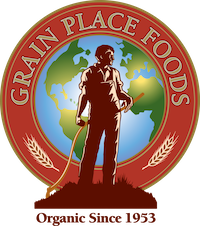9 YEAR ROTATION
Crop Rotation

Pasture grasses
Our rotation includes four years of pasturing. This length of time supplies primary nutrients (nitrogen, phosphorus and potassium) and micro nutrients for plant growth, but also is a source of organic matter.
Yellow Corn
Yellow corn is a staple food crop that is grown organically to provide a source of nutritious grain for human consumption. The Grain Place grows yellow corn for direct consumption or for processing into products like cornmeal, corn flour, or corn flakes.
Popcorn
Popcorn adds diversity to the crop rotation system. Popcorn plants, like other corn varieties, have a tall and dense growth habit that shades out weeds. This shading effect helps suppress weed growth and reduces the need for herbicides or mechanical weed control methods.
Soybeans
Soybeans are leguminous plants that have a unique ability to form a symbiotic relationship with nitrogen-fixing bacteria called rhizobia. These bacteria reside in nodules on the soybean roots and convert atmospheric nitrogen into a usable form for plants.

Barley
Barley is known for its ability to scavenge and absorb excess nutrients from the soil, including nitrogen, phosphorus, and potassium. This helps prevent nutrient leaching and runoff, keeping these valuable resources within the root zone and available for subsequent crops. When barley is terminated and incorporated into the soil, these accumulated nutrients are released and become accessible to following crops, contributing to improved nutrient cycling and reducing the need for external inputs.

More Pasture
The Grain Place uses a variety of pasture grasses and legumes to assist in replenishing the soil. This includes a variety of both warm season and cool season grasses, red clover, alfalfa, and chicory.
OUR Fields
The farm’s 280 acres host 18 fields, farmed in a 9-year rotation. We grow corn, popcorn, soybeans and barley. We also plant green cover crops on the fields we are grazing with cattle each year. Bordering the farm and between fields, we have planted rows of trees, which prevent pesticide drift from neighboring farms and enrich our farm ecosystem. On the farm property, you will also find Grain Place Food’s facility, as well as farm pigs, three houses, lots of trees and some farm buildings.
This is an example of our fields for 2022. each field is a section that is about 15-20 acres and rotates yearly.

Soil Health
Healthy organic soil is crucial for sustainable agriculture, improved plant health, and environmental preservation. By promoting natural nutrient cycling, water conservation, disease suppression, and carbon sequestration, organic soil contributes to the long-term health and productivity of ecosystems. You can learn more about how we take care of our soil by watching our documentary, Dreaming of a Vetter World.


Cover
Crops
Cover crops play a vital role in sustainable agriculture by enhancing soil health, improving nutrient cycling, reducing environmental impacts, and promoting long-term productivity. The choice of cover crop species depends on factors such as climate, soil type, and specific objectives of the farmer or crop rotation system.

Livestock and Grazing
Silvopasture is a land management practice used in organic farming that combines trees, forage crops, and livestock grazing. It involves intentionally integrating trees into pasture areas to provide benefits for both livestock and the environment.

Cows and grazing
For years now, the Grain Place Foods sign near the highway has affirmed our belief that “how your food is produced does matter.”
We grow high-quality, certified organic grains, and raise cattle and pigs that, while not certified as organic, are raised with the same standards and commitments. The cattle graze the fields we are not planting with crops each year, as a part of the rotation cycle that improves the soil quality.
Cattle grazing plays a vital role in regenerative agriculture by enhancing soil health, promoting biodiversity, sequestering carbon, and supporting sustainable land management practices.
Pigs and silvopastures
Pigs can play a valuable role in silvopasture systems.
Pigs are excellent at rooting and digging. They use their snouts to search for food, turning over the soil in the process. This natural behavior helps break up compacted soil, improve soil aeration, and promote nutrient cycling by exposing organic matter to decomposition.
Pigs have the ability to clear and prune vegetation within the silvopasture system. They can consume or trample on undergrowth and low-lying vegetation, reducing competition for resources and creating space for desired tree and forage crop growth.
The pigs are also fed grain waste from the processing facility on site.
Our Pollinators




GET IN TOUCH
Drop us a line we are happy to answer any questions or just say hi.

